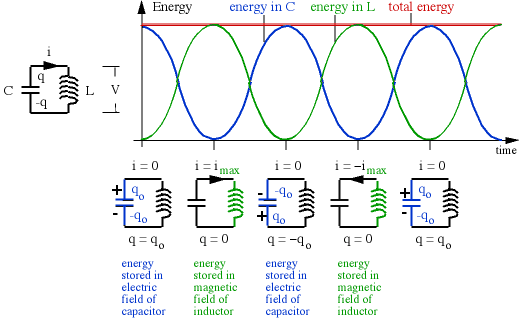 http://www.animations.physics.unsw.edu.au/jw/images/resonance3.gif
http://www.animations.physics.unsw.edu.au/jw/images/resonance3.gif
Coils of wire are one of the fundamental constructions of electronic circuits. Because increasing the length of a wire can increase the inductive storage of a circuit, it is convenient to put long lengths of wire into coils in order to save space. The primary coil of a Tesla coil is one of the larger, more exaggerated examples of this. It is built large in order to handle the large current and voltage that Tesla coils need in order to operate. In conjunction with the capacitor, it forms one of two inductor-capacitor, or LC, circuits in the Tesla coil.
LC circuits operate in the following way: When the capacitor of the circuit is full, it releases its charge into the circuit. Typically, that would be it, but the inductor, in this case the primary coil, keeps the current moving by storing the energy in its magnetic field and allows the capacitor to be charged again, with reverse polarity. This cycle can continue as long as the circuit is connected to an AC power source.
Ninety-nine times out of one hundred, it makes the most sense to make the primary out of copper pipe. It could be made out of strips of copper, but since 1/4 or 3/8 inch pipe is available in thirty to sixty foot lengths, it makes little sense unless you happen to have a large quantity on hand. The diameter of the pipe, the number of turns, and the capacitance of the main capacitor will all help determine the resonant frequency of the circuit, or the frequency at which the energy alternates from being fully positively charged to fully negatively charged.
I chose fifty feet of 3/8 inch copper pipe for my build. Since it was already in a handy coil, all I had to do was bend it out into the flat spiral shape that I wanted, using its natural curve to help me. To support this massive piece of circuitry, I cut some P-Tex into four guides to keep it all together. Unfortunately, when putting them on, the coil became a cone shape rather than flat. This was not a hindrance, however, since many primaries are wound as cones anyway.
